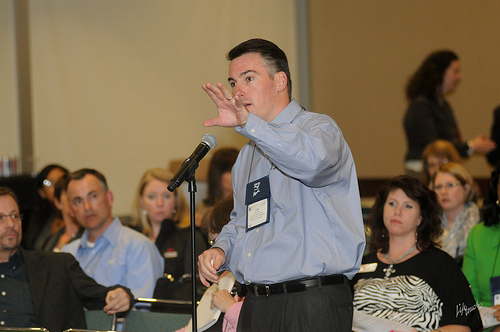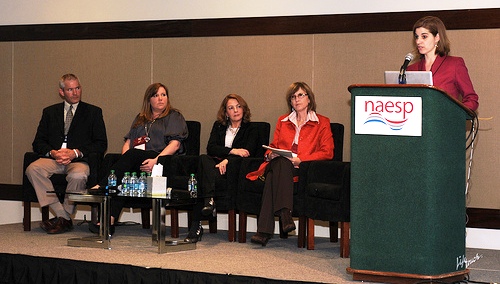Bullying Town Hall Shines Spotlight on Complex Problem
Conference News Online March 2012 Possible solutions to the serious issue of bullying were examined as NAESP and education.com sponsored a Bullying Town Hall Meeting during the 2012 NAESP Conference and Expo on Thursday, March 22.

Conference News Online
March 2012
Possible solutions to the serious issue of bullying were examined as NAESP and education.com sponsored a Bullying Town Hall Meeting during the 2012 NAESP Conference and Expo on Thursday, March 22.
Participants viewed a trailer for the soon-to-be-released documentary “Bully” that shows the devastating effects of bullying on families and communities. The short trailer was disturbing, presenting scenes of actual bullying behavior and the students and families who endured it. It focused on what has not been handled well in the school setting when children are bullied. Neither education.com nor NAESP are taking a stand regarding the movie’s contents, but provided it as a conversation starter and point of information for school leaders.
Amanda Nickerson, an expert on bullying from education.com, reviewed basic, but important information on the foundational definition of bullying. This is especially important because the term is often misused to describe many types of behavior. She defined bullying as intentional and repeated actions inflicted by a peer or peers operating from a point of power. Dr. Nickerson also described various myths about bullies and victims. One myth that stood out was that bullying only involves the perpetrators. Most often bullying is a public event with many, many witnesses. This is where, as a principal, I wonder, “Why didn’t the bystanders stop this behavior?”
The remainder of the meeting was devoted to answering the question of what principals can do to ensure that their schools are safe from bullying behaviors. Various solutions were offered by panel members during the town hall portion of the program. The panel included a parent of a child who had been repeatedly bullied, an elementary principal, an elementary counselor, and an expert on bullying.
What can a principal do? First and foremost the principal must ensure that there is a positive climate in the school among students and staff members. Principals also should understand the extent of bullying behavior that is exhibited at their school. Examining discipline data carefully helps principals identify “hot spots” where bullying might occur (bus, lunchroom, recess) so that active supervision can be provided. School staff must develop an anti-bullying policy that includes a clear definition of what behaviors are classified as bullying as well as which consequences on a continuum will be issued. Finally, training on all aspects of bullying should be provided for staff, parents, students, and volunteers.
Several questions from the audience related to the difficulty of making community members aware of our efforts regarding bullying without making the public think that we have a bullying problem. However, panelists made clear that communication is the key: school leaders should be proactive in explaining school initiatives concerning bullying. This information can be shared on the school web site, pamphlets, special workshops, and through school and district policy and procedure leaflets.
Schools that have successful anti-bullying programs often use an emotional/social curriculum. When choosing such a specialty program, principals should select one that is research-based, comprehensive, can be used and implemented easily, and has the buy-in of the administrative and school staff. Any program must have sustainability with existing resources. But what if your school doesn’t have resources for a specialized curriculum? Communicating with the school and surrounding community is free. So is establishing a positive and safe school climate. Students who feel connected to the school will be less likely to bully others or accept when others exhibit bullying behaviors. Teachers must accept reports of bullying quickly and respond appropriately. NAESP has compiled a number of valuable resources for principals on a special webpage (www.naesp.org/bullying). The website includes a bookmark that you can download and print as well as a Report to Parents on bullying.
This session was a great reminder of what I need to do as a school leader. Do we have a clear understanding of the definition of bullying at our school? Can our children, parents, and teachers describe the difference between bullying, teasing, and conflict? This last question was new for me; and unfortunately, the answer is “No.” I have some work to do.
—Sandi Cox, principal, Norview Elementary School, Norfolk, Virginia

